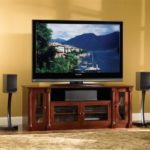Satellite TV connection
One of the advantages of satellite television is the low cost of connection. As you can see from the practice, in order to connect a satellite dish to a TV, you have to pay about $ 160. Other benefits include no subscription fee (unlike cable TV), high-quality image and sound, a large number of television channels for every taste. So, if the satellite equipment will have 3 converters (heads), then you can configure from 25 to 40 free Russian-language TV channels (depending on the satellites you have chosen).
Content
The principle of operation of the antenna
A satellite dish is essentially a mirror reflecting the signal from the satellite. The reflected signal goes to the converter, and the last one - sends the data to the receiver. It is from him, the television receiver through the television cable, and receives the converted signal.
According to the standard, satellites are often chosen: Sirius 5.0E, Amos 4.0W, Hotbird 13.0E, since these satellites can provide a large selection of broadcasts that satisfy any preferences. But, since technical progress does not stand still, other satellites appear, providing a large selection of TV broadcasts. And you have the right to choose the one that best suits your requirements.
How to connect the TV to a satellite dish
To connect the TV to the satellite dish, there are 2 ways:
- the cable is connected directly to the television receiver;
- connection is via the receiver.
Direct connection to the TV receiver
As you know, in order to watch satellite TV, a receiver is required. But in modern TVs began to install DVB-S2 digital tunerswhich make it possible not to use an external receiver, connect the cable to the TV directly from the “dish”, and catch the TV from the satellite.
To find out if the TV supports this function, you can look at the description of the device, which can be found on various websites selling consumer electronics.

But, unfortunately, the TV will catch only free (not coded) foreign channels. To watch domestic TV via satellite, you need to buy CAM modulewhich connects to DVB-S2 via the PCMCIA interface.

The CAM-module is purchased together with a package of suitable satellite TV, which you can choose from among the many operators offering this service. The convenience of using such a connection is obvious:
- no need to purchase a receiver separately;
- only one remote control is required to switch channels.
Before purchasing a satellite TV package with a CAM module, ask the provider if their modules are compatible with a specific TV model.
Plate installation
Before you start connecting the cable to a TV without a receiver, you must assemble the entire set of satellite equipment you have purchased and properly position the antenna itself. Place to install the plate should be such as to provide good guidance for the satellite. By the way, the wrong choice of location is a frequent reason that TV does not catch the signal. In addition, the antenna will need access to adjust.Therefore, it should be located in an accessible place. Various interferences, such as buildings, trees, and various structures on the signal reception path, greatly degrade the quality of a television broadcast.
Basically, broadcasting TV satellites are concentrated in the direction from the southeast to the southwest. Satellites located in the south have the greatest height above the horizon.
Cable preparation
When the plate installation is complete, you will need to prepare F-connector and cable to connect the antenna to the TV. The F-connector is a simple grommet that is screwed onto the cable, so it is important that it be threaded.


If the output on the TV or receiver is adapted to the F-connector, then it will be easy to connect the TV to a satellite dish. In the case when your TV set has a normal antenna output, you will need buy an adapter.



You can, of course, buy a regular antenna plug, but they are often of poor quality. In the case of an F-ki with an adapter, it turns out a universal plug that can be connected to both the F-output and the antenna.
Before you connect the cable to the TV, do the following.
- Remove the top insulation layer from the cable. You will see the primary screen, consisting of twisted thin wire that needs to be bent.
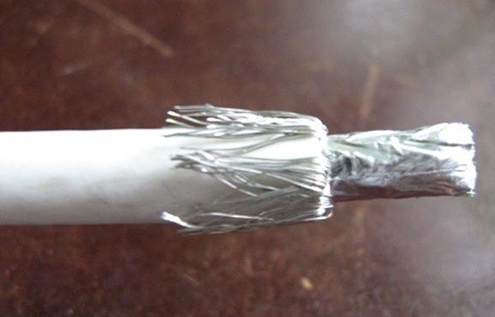
- Under the primary screen, you can see the second - from foil. Foil screen clipped as shown in the image below.
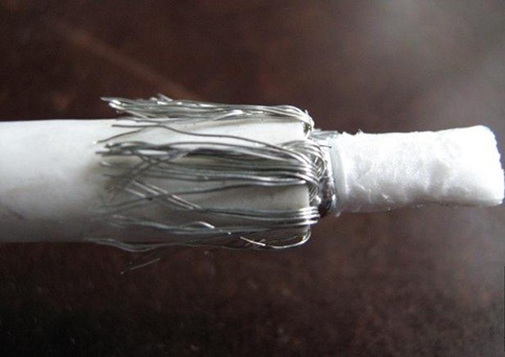
- After that, remove the insulation to get to the central (copper) core.
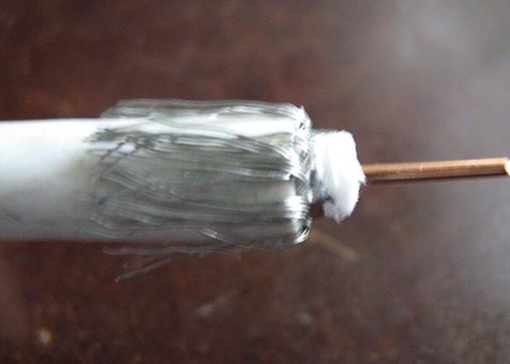
- Before connecting the F-connector (antenna plug), the core must be cleaned with a knife from the enamel applied on it, after which F-ka is screwed onto the cable. Now, it can be connected to the receiver, or by winding the adapter to the antenna output. The second end of the cable is connected to the converter located on the antenna.
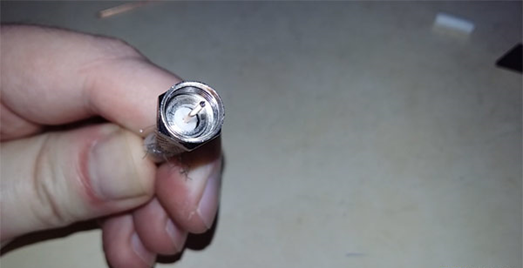
Connection and setup
To prepare for watching TV, you need to do the following:
- The plug must be connected to the connector of the TV set called “LNB Satellite IN” (the setting is made on the example of the LG television set).
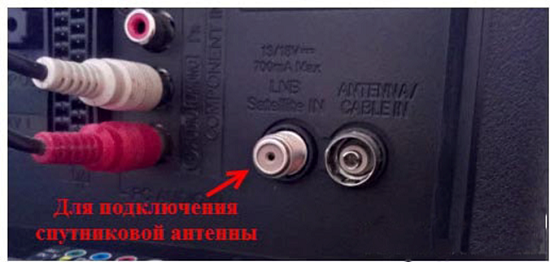
- Now, after connecting the antenna to the TV, you can turn on the device, go to the settings and select automatic channel scan.
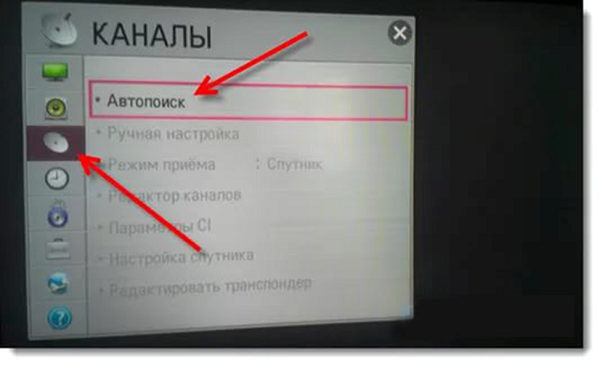
- When asked where to search for broadcasts, you need to select “Satellite” and click “Next”.
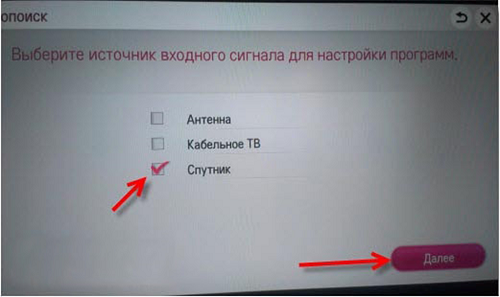
- At this step, it is possible to select the required satellite,for its subsequent scanning. Also available on this page are other settings related to this satellite. After selecting it, click “Next”.

- When you select advanced settings, a window will appear with various parameters showing the values related to the quality of the received signal, as well as its level. The image below shows that the signal level is at maximum value. To add a new satellite, there is a corresponding button located at the top of the window. After closing this menu and clicking “Next”, you must specify the conditions for the search.

- If you do not have a CAM module, and you want to find free broadcasts, check the box next to the “Skip encrypted channels” line. After installing the necessary data, click on “Run”.

- Next will start the search for broadcasts. During the search, you can observe the number of TV and radio channels that were detected. If you stop the search prematurely, the channels found before will still be saved.

- After the scan is completed, you can start watching satellite TV. If you go to the telly settings in “Channels” section, then you can see a lot more options.For example, you can sort the channels, edit the transponder, tune the satellite and so on.

To switch between different TV signal sources, whether it is satellite TV or cable, HDMI signal or another, the INPUT button is pressed on the remote control and the required one is selected.
Connection via receiver
After satellite TV appeared, the receiver became an indispensable device that connects between a TV and a satellite dish. The receiver acts as a decoder that receives a signal in the same format, which converts it, and transmits the decoded signal to the television through a connection via a television cable.. Read more about choosing this device in the article. digital set top box.

How to properly connect the satellite antenna to the device? In modern television receivers, you can connect the cable to the TV through the receiver through the following connectors.
- Hdmi connector Connecting to this input gives a high-resolution picture, and this is the most modern and high-quality connection. HDMI does not require transcoding from digital to analog. In this way, you can connect the tuner to the laptop to use the latest as a tv.

- Scart connector. Popularly called “Scallop” and is the audio and video connector of the European standard. Provides good image quality, no worse than a component cable.

- Component connector (Y Pb Pr). It is the highest-quality connection using a special component cable that can be used both to transmit a high-resolution signal (1080i) and to connect a television antenna through the receiver. It is called a component cable because the transmission of the components of a video signal occurs on several channels. This connector can be used to transmit HDTV.

- RCA - interface, better known as “Tulips”. The main advantages of this interface - simplicity and accessibility in the connection, and how to connect the TV set with the receiver - can not cause difficulties. Simply insert plugs with a specific color into the same color socket. It can be called one of the most ancient ways to connect peripherals to the TV, and it is present in almost all TV sets. The aggregate connected in such a way produces a picture that does not differ in high quality, but is quite acceptable for TV sets with a small diagonal.

- Conventional antenna plug. Such a connection is also called an RF connection and is familiar to all who connected the indoor antenna. The quality of signal transmission with such a connection wants to be the best.

Thus, the connection of satellite equipment to a television set is not difficult. The main thing is the correct choice of the directivity of the antenna, the connection of equipment with cables and the setting of the television reception. Setting up a satellite receiver is just the opposite - a complicated process that requires some knowledge to carry out the calculations necessary for the correct orientation of the dish mirror to the satellite groups. After that, the reception itself is set up (this requires knowing the necessary parameters for input). ABOUT setting up the receiver with your own hands You can find out by looking at it video.

/rating_on.png)
/rating_half.png)






